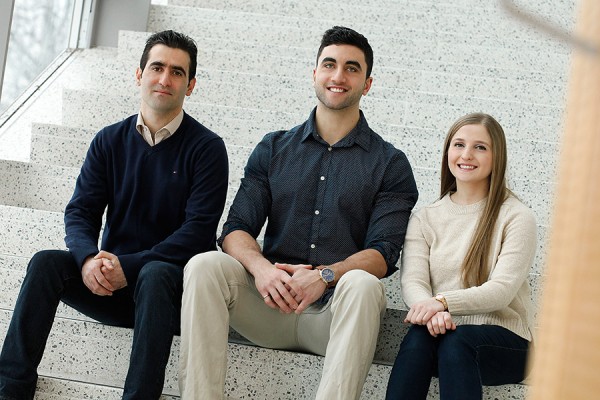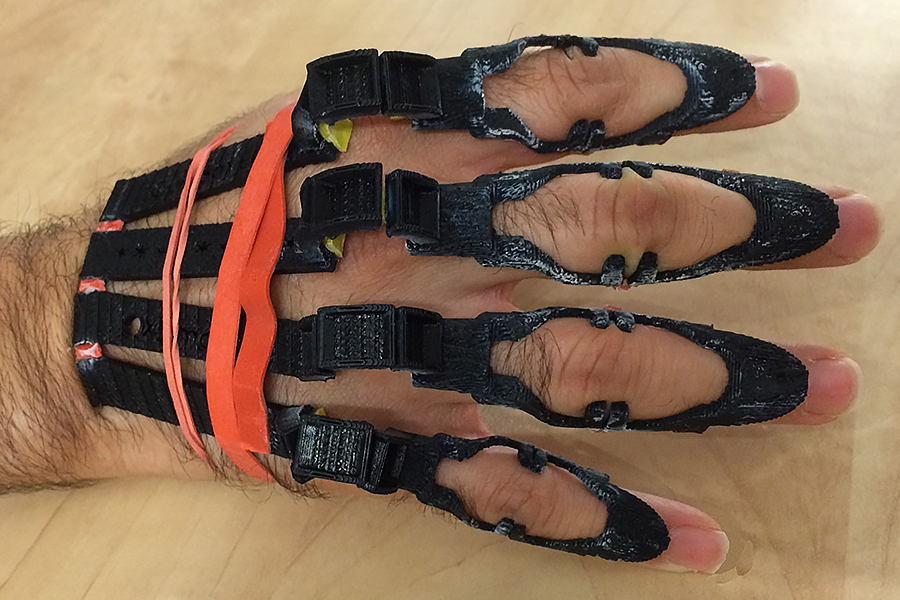 Research conducted by mechanical engineering students Hamed Kalami, Andre Khayat and Liza DiCecco was highlighted at the12th International Federation of Automatic Control Workshop on Intelligent Manufacturing Systems on December 5 to 7 in Austin, Texas. Kalami and Khayat received the Young Researcher Award for their work on a 3D printable hand brace that can assist people with connective tissue disorders.
Research conducted by mechanical engineering students Hamed Kalami, Andre Khayat and Liza DiCecco was highlighted at the12th International Federation of Automatic Control Workshop on Intelligent Manufacturing Systems on December 5 to 7 in Austin, Texas. Kalami and Khayat received the Young Researcher Award for their work on a 3D printable hand brace that can assist people with connective tissue disorders.
Mechanical engineering students at the University of Windsor have been recognized on an international stage for their research in designing a 3D printable hand brace that can assist people with connective tissue disorders.
Master’s student Andre Khayat and doctoral candidate Hamed Kalami received the International Federation of Automatic Control (IFAC) Young Researcher Award after Khayat presented to an audience of industry leaders and academic researchers at the federation’s Workshop on Intelligent Manufacturing Systems held December 5 to 7 in Austin, Texas.
Based on their research on exoskeleton design and fabrication challenges for the hand region, the two created a cost-effective, 3D printable prototype that offers complete customization.
“We reverse-engineered traits based on a fully functional hand to create custom 3D printable prototypes,” said Khayat, a mechanical engineering undergraduate at the time who is now completing master’s studies in the integrated BASc-MASc program.
“Our research has the potential to help those affected with diseases such as Ehlers-Danlos syndrome — a disorder in which connective tissues and building blocks of the body are compromised, making tasks such as writing on a piece of paper difficult and painful.”
Using this technique, consumers could simply place their hand in a scanner and choose a custom fit brace based on aesthetics and functionality. Khayat said this technique allows for rapid production and accommodates people who have trouble finding properly fitting braces.
“It was cool to see the bigger industries doing some of the stuff we’re doing,” Khayat said. “Our field is a newer field, so there are not a lot of people working with additive manufacturing. To go up and see a CEO present exactly what I want to do and to be able to talk to him after was great. Making connections was truly the most valuable part of the conference.”
Liza DiCecco, an undergraduate in the material stream of mechanical engineering, also attended the conference to present her research on a predictive model that can help improve surface smoothness.
“One of the issues with additive manufacturing is you’re taking a 3D part and cutting everything into 2D slices, which creates a staircase effect,” DiCecco said.
For example, DiCecco said her research could help ensure a part fabricated for an airplane has a smooth finish that reduces drag or that a hand brace like Khayat’s is not rough against someone’s skin.
Professor Jill Urbanic, the students’ faculty advisor, said she was pleased by their reception at the IFAC workshop.
“It is rare for undergraduate research to make it to an international, refereed conference and be so well-received,” she said.

Windsor engineering students have won international recognition for design of a 3D printable hand brace to assist people with connective tissue disorders.

